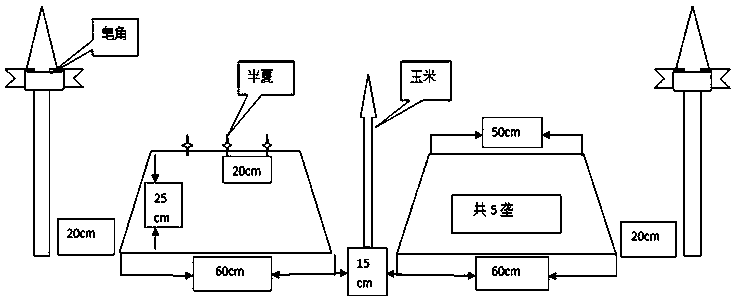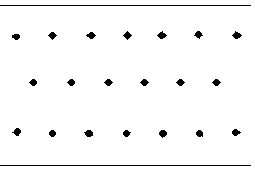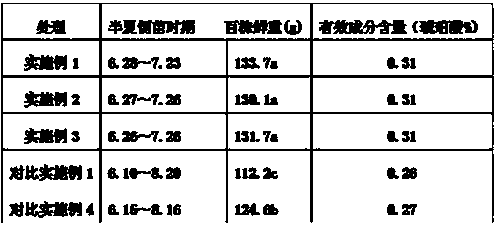A three-dimensional cultivation method for intercropping Pinellia saponins and corn
A technology of three-dimensional cultivation and saponins, applied in botany equipment and methods, cultivation, plant cultivation, etc., can solve the problems of low land utilization rate, need for artificial shading, tree canopy shading, etc., to increase ground temperature and avoid herbicides The effect of using and protecting the ecological environment
- Summary
- Abstract
- Description
- Claims
- Application Information
AI Technical Summary
Problems solved by technology
Method used
Image
Examples
Embodiment 1
[0026] Example 1: Intercropping pinellia saponins and corn
[0027] A method for cultivating saponins intercropping pinellia and corn, comprising the following steps:
[0028] (1) Plant 5-year-old saponins seedlings, control plant spacing 150cm, row spacing 400cm, flat cropping;
[0029] (2) 5 ridges with a width of 60 cm at the bottom of the ridge, a width of 50 cm above the ridge, a height of 25 cm, and a distance of 15 cm at the bottom of the ridge are erected in the row 20 cm away from the saponin tree;
[0030] (3) Plant 3 rows of pinellia on the ridge, with a row spacing of 20cm and a plant spacing of 8cm, one in each hole, with a depth of 3 to 4cm, symmetrically sow in 2 rows on the side, and cross-seek in the middle row;
[0031] (4) Plant 1 row of corn between the 4 ridges in the saponin row, with a plant spacing of 20cm and a density of 3300 plants / mu.
Embodiment 2
[0032] Example 2: Intercropping pinellia saponins and corn
[0033] A method for cultivating saponins intercropping pinellia and corn, comprising the following steps:
[0034] (1) Plant 5-year-old saponins seedlings, control plant spacing 150cm, row spacing 400cm, flat cropping;
[0035] (2) 4 ridges with a width of 75 cm at the bottom of the ridge, a width of 60 cm above the ridge, a height of 25 cm, and a distance of 20 cm are formed in the row 20 cm away from the saponin tree;
[0036] (3) Plant 4 rows of pinellia on the ridge, the row spacing is 20cm, the plant spacing is 8cm, one in each hole, and the depth is 3-4cm;
[0037] (4) Plant 1 row of corn between the 3 ridges in the saponins row, with a plant spacing of 20cm and a density of 2500 plants / mu.
Embodiment 3
[0038] Example 3: Intercropping pinellia saponins and corn
[0039] A method for cultivating saponins intercropping pinellia and corn, comprising the following steps:
[0040] (1) Plant 5-year-old saponins seedlings, control plant spacing 150cm, row spacing 400cm, flat cropping;
[0041] (2) Three ridges with a width of 110 cm at the bottom of the ridge, a width of 90 cm above the ridge, a height of 25 cm, and a distance of 15 cm are erected in the row 20 cm away from the saponin tree;
[0042] (3) Plant 5 rows of pinellia in the middle of the ridge, with a row spacing of 20cm and a plant spacing of 8cm, one in each hole, and a depth of 3 to 4cm;
[0043] (4) Plant a row of corn between the two ridges in the saponin row, with a plant spacing of 20cm and a density of 1667 plants / mu.
PUM
 Login to View More
Login to View More Abstract
Description
Claims
Application Information
 Login to View More
Login to View More - R&D
- Intellectual Property
- Life Sciences
- Materials
- Tech Scout
- Unparalleled Data Quality
- Higher Quality Content
- 60% Fewer Hallucinations
Browse by: Latest US Patents, China's latest patents, Technical Efficacy Thesaurus, Application Domain, Technology Topic, Popular Technical Reports.
© 2025 PatSnap. All rights reserved.Legal|Privacy policy|Modern Slavery Act Transparency Statement|Sitemap|About US| Contact US: help@patsnap.com



